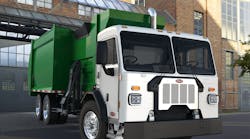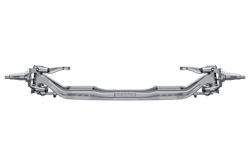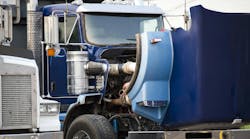Peterbilt Motors Co. recently showed off an electric battery-drive demonstration version of its Model 520 vocational chassis, while unveiling three new cab configurations for that model as well.
The OEM also said it is adding the new PACCAR 20,000-lb. and 22,000-lb. wide track steer axles to its vocational chassis lineup.
At the WasteExpo 2017 show in New Orleans, LA, this week, Peterbilt unveiled an Model 520 demonstration truck in refuse configuration equipped with a battery-electric drive system built by Transpower ElecTruck.
The ElecTruck system uses high-power electric motors, inverters and batteries to power commercial trucks weighing as much as 80,000 lb., and has also accumulated over 80,000 miles of Class 8 heavy duty use in a variety of commercial applications since 2013, noted Joshua Goldman, TransPower’s vice president of business development.
The variant of TransPower’s system developed for the Model 520 refuse truck uses a 300 kilowatt-hour battery pack so it can operate for up to 65 miles or eight hours on a single charge. The ElecTruck system also features a 70 kilowatt onboard battery charger that can fully charge the truck’s lithium-ion battery pack in two-four hours, Goldman noted.
“Powering heavy refuse trucks is a logical next step in the adaptation of our electric drive technology to vehicles requiring conversion to zero-emission operation,” he said in a statement.
“Peterbilt is working closely with its partners to explore the capabilities and performance of battery-electric drive systems,” added Scott Newhouse, Peterbilt's chief engineer. “Customers in urban environments and applications such as drayage and refuse collection stand to benefit from the zero-emissions performance of these advanced vehicles.”
Peterbilt is also now offering three different cab configurations for its Model 520 as well: Left-Hand Drive, Right-Hand Drive and Right-Hand Stand-Up Drive in addition to its existing Dual Seated Drive configuration, the company announced.
The Left-Hand Drive and Right-Hand Drive configurations provide a comfortable seated driving position while in transit or performing curbside operations, while the redesigned Right-Hand Stand-Up cab configuration provides easier cab entry and exit ingress in applications where refuse drivers must leave the cab multiple times on their routes.
Driver ergonomics are further enhanced by standard adjustable seat, angled steering wheel and dead-pedal to rest their left foot during operation, noted Robert Woodall, Peterbilt’s assistant general manager of sales and marketing, in a statement.
“Offering a full lineup of cab configurations for the refuse market further enhances the versatility of this vocational vehicle for our customers’ operations,” he explained.
Peterbilt is also now providing the new PACCAR 20,000-lb. and 22,000-lb. wide track steer axles as options on its vocational models, available with standard front air disc brakes or optional drum brakes as well as with other suspensions and wheel end options.
Both axle ratings will be available in the Models 567, 520, 389, 367, 365, 348 and the 389 glider kit, the OEM added.
Kyle Quinn, Peterbilt’s general manager and PACCAR senior vice president, noted in a statement that this new vocational steer axle is ideal for demanding applications such as refuse, construction and heavy-haul based on its combination of weight-savings and durability. It also provides other operational benefits such as improved maneuverability via its turn angle of up to 50 degrees, he said.




